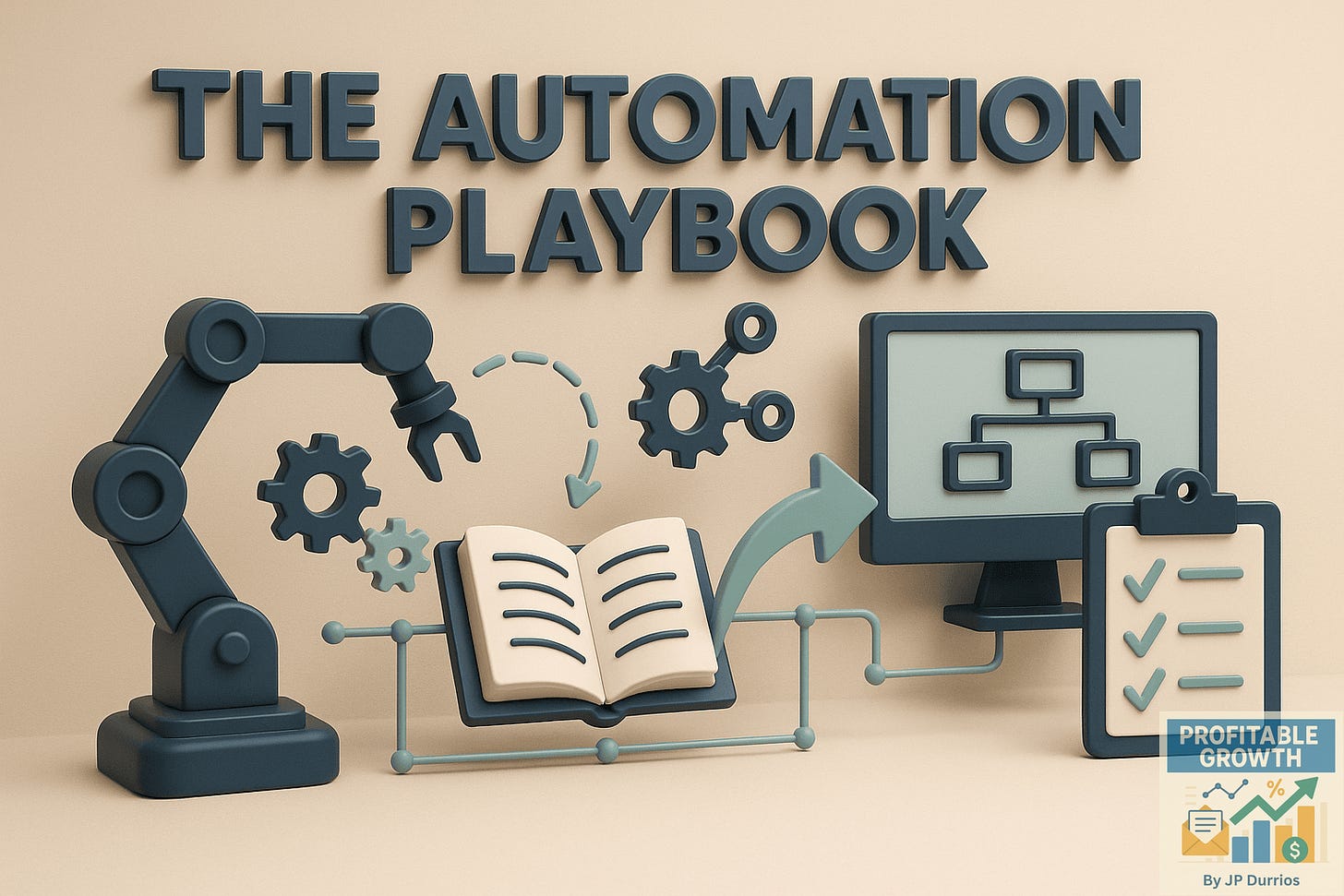Bottlenecks to Breakthroughs: Metrics, Mindsets, and Automation That Unlock Growth
JP's Profitable Growth - Vol 05
Hi (👋 ), welcome back to a new edition of Profitable Growth, an operator's newsletter for operators, at the cross-section of AI, operating cultures and financial discipline.
In this week's edition (est. 6 min. read):
Main Article
Quick Hits
Number to Know
Spot and Unlock Your Startup’s Next Inflection Point
An inflection point is when the scrappy, all‑hands‑on‑deck approach that once powered your startup begins to stall growth. Left unchecked, manual hustle mutates from super‑power to silent killer, consuming cash, talent, and time. The antidote is a deliberate shift to data‑driven systems and targeted automation. This guide breaks down:
Early warning indicators that your hustle is now hurting you.
Metrics that quantify strain before customers feel it.
A three‑step Automation Playbook (Prioritize ▶ Pilot ▶ Scale).
Cultural guardrails that keep tech and talent aligned.
Use this as a diagnostic tool and roadmap to turn looming bottlenecks into scalable advantages.
🧐 Why Inflection Points Matter
Even at tech startups, manual processes often stand as the company’s backbone at the onset. When the teams are small, you can get a lot done and quickly. However, as growth materializes and these companies expand, critical junctures start happening across the organization: maturation points where manual hustle becomes a bottleneck rather than a booster. Those are inflection points, and recognizing them early is essential for scaling your business.
Shortcuts with manual work are fine early on, but as volume and complexity increase and you hire more people on the team, what your small founding team could handle reliably doesn’t scale, and the price of errors quickly outweighs any time you save.
Automation gaps become a race gap: if you keep doing things manually while competitors get to market with more intelligent systems, they’ll ship faster and win customers you can’t.
Investors pay a premium for startups that already run on scalable, repeatable processes and produce steady margins.
💡 Rule of Thumb: If headcount grows >30 % YoY while revenue per employee is flat or dropping, the hustle has hit diminishing returns.
🔎 How to Identify Inflection Points
Identifying inflection points requires a keen understanding of how growth alters organizational dynamics. For example, as your team grows from fewer than 50 employees to a more substantial number, individual initiative may give way to more collective decision-making, and reaching product-market fit is another. Assessing your company’s readiness and timing to embrace automation at this stage can make the difference between scaling gracefully and stagnating.
Check my blog post for the 4 signals indicating that you may have reached that point.
Here are sample metrics that spotlight bottlenecks:
Capacity Utilization: % of max throughput you’re using. If consistently >85 %, you’re one surprise away from fire‑fighting.
First Pass Yield (FPY): % of tasks finished right first time. Target ≥95 % for digital flows; anything lower screams for automation.
Overall Equipment Effectiveness (OEE): Not just for hardware. Adapt the uptime × speed × quality formula to APIs or data pipelines.
Time‑to‑Decision (TtD): Median hours from data availability to call made. Benchmark <24 h for tactical, <7 days for strategic.
Employee NPS linked to process friction. Declining eNPS often precedes churn by 1–2 quarters.
🤖 The Automation Playbook
While we all agree automation is crucial for breaking the cycle of growing manual inefficiencies, the journey if rife with challenges.
Innotech has an interesting approach to systemizing and de-risking the process. I used a similar framework at ServiceTitan and MarketShare to help teams prioritize strategic innovation over mundane tasks.
1️⃣ Prioritize
Build a scoring matrix. Info‑Tech and DXC document this “value‑first” lens to ensure automations attack the biggest pain first, not the easiest script.
Map the outcome on a 2x2 grid. Plot each workflow as Quick Win (high value / low effort) or Strategic Bet (high value / high effort). Automate one of each to balance fast ROI with long‑term leverage.
2️⃣ Pilot
Time-box experiments. Keep pilots under 90 days, long enough to gather data, short enough to abandon if ROI misses targets.
Instrument KPIs: Cycle‑Time (minutes / task) and Margin Lift (% cost saved) are common yardsticks. Collect a baseline a month before go‑live; compare weekly during the pilot.
Staff a nano team. A typical pilot team: one business owner, one automation ninja, one analyst, and a change champion from the front line — small enough to move fast, diverse enough to surface risks.
Define “Kill or Scale” gates. Success means ≥ 30 % faster cycle‑time or ≥ 20 % margin lift. Missed the mark? Do a retrospective, share the learnings, retire the automation and avoids sunk‑cost bias.
3️⃣ Scale
Fold into the core roadmap. Transition stable automations into the engineering / ops backlog, assign owners, and track uptime in the same dashboards as production code McKinsey & Company.
Ruthlessly sunset legacy steps. Every automated task should delete or consolidate at least one manual touch point. Failure to retire old steps is a top source of automation technical debt.
Layer in continuous process mining. Deploy tools like UIPath to watch live event logs, revealing new friction without manual discovery.
🙋♂️ Addressing Cultural and Organizational Barriers to Automation
For this to work and become second nature across the organization, you need cultural and organizational guardrails:
Transparency by Default – Public dashboards over slide‑deck gatekeeping.
Upskill, Don’t Replace – Pair automation roll‑outs with role redesign and micro‑learning paths.
Decision Cadence – Adopt an 80% confidence, 100% commitment mantra to curb analysis paralysis.
North‑Star Alignment – Tie every bot, script, or AI agent to a revenue or customer‑experience KPI.
Final Thought
This is a rite of passage. Treat each inflection point as a design review, not a crisis. Systemize what scales, automate what repeats, and elevate your employees’ quality of life. They’ll create more enterprise value as a result.
Last, it’s also an excellent opportunity to foster a Kaizen culture and encourage “Citizen Developers” to step up. But that’s probably for another post 🙂
Questions or war stories? Ping me on LinkedIn. Happy to help you think through how to turn your next bottleneck into your biggest growth lever.
Quick Hits: What's On My Radar
Trend: The amount of early-stage (seed and Series A) capital raised worldwide in Q1 '25 was at the lowest level in over a year. Capital remains expensive everywhere, and mega deals are taking the lion's share of the dollars raised. Those and their press coverage are masking the actual scarcity.
New App: Tabs is an AI‑powered revenue‑automation platform that ingests any contract or usage data to extract terms, generate invoices for any pricing model, and automate billing, revenue recognition, dunning, and cash application. Integrated with QuickBooks, NetSuite, tax and payment rails, it saves hundreds of hours and cuts days‑sales‑outstanding by ~20 days.
Number to Know
3:1
That's the customer lifetime value to customer acquisition cost ratio, or LTV:CAC for short. While a 3:1 LTV:CAC ratio is a solid benchmark and varies by industry, striving for higher ratios can indicate superior efficiency and profitability. That said, a too high ratio may suggest that you are underinvesting in growth.
Until next Tuesday, 👋
JP




